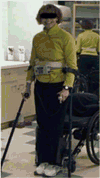Functional electrical stimulation and spinal cord injury
- PMID: 25064792
- PMCID: PMC4519233
- DOI: 10.1016/j.pmr.2014.05.001
Functional electrical stimulation and spinal cord injury
Abstract
Spinal cord injuries (SCI) can disrupt communications between the brain and the body, resulting in loss of control over otherwise intact neuromuscular systems. Functional electrical stimulation (FES) of the central and peripheral nervous system can use these intact neuromuscular systems to provide therapeutic exercise options to allow functional restoration and to manage medical complications following SCI. The use of FES for the restoration of muscular and organ functions may significantly decrease the morbidity and mortality following SCI. Many FES devices are commercially available and should be considered as part of the lifelong rehabilitation care plan for all eligible persons with SCI.
Keywords: Electric stimulation; Electrodes; Muscle spasticity; Neurogenic urinary bladder; Paralysis; Pressure ulcer; Rehabilitation; Spinal cord injuries.
Copyright © 2014 Elsevier Inc. All rights reserved.
Figures









References
-
- Popovic MR, Keller T, Papas IPI, Dietz V, Morari M. Surface-stimulation technology for grasping and walking neuroprostheses. IEEE Eng Med Biol Mag. 2001;20(1):82–93. - PubMed
-
- Ragnarsson KT. Functional electrical stimulation after spinal cord injury: current use, therapeutic effects and future directions. Spinal Cord. 2007 Sep;46(4):255–274. - PubMed
-
- Agarwal S, Kobetic R, Nandurkar S, Marsolais EB. Functional electrical stimulation for walking in paraplegia: 17-year follow-up of 2 cases. J Spinal Cord Med. 2003;26(1):86–91. - PubMed
-
- Naples GG, Mortimer JT, Scheiner A, Sweeney JD. A spiral nerve cuff electrode for peripheral nerve stimulation. 1988:905–916. - PubMed
-
- Agnew WF, McCreery DB, Yuen TG, Bullara LA. Histologic and physiologic evaluation of electrically stimulated peripheral nerve: considerations for the selection of parameters. Ann Biomed Eng. 1989;17(1):39–60. - PubMed
Publication types
MeSH terms
Grants and funding
LinkOut - more resources
Full Text Sources
Other Literature Sources
Medical
Miscellaneous

